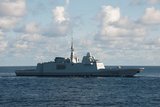Northrop Grumman demonstrates G/ATOR
Northrop Grumman Corporation and the US Marine Corps Program Executive Officer for Land Systems demonstrated the AN/TPS-80 Ground/Air Task Oriented Radar (G/ATOR) system to senior Department of Defense leaders at the Pentagon on Oct. 5 and 6.
Currently in test at the company's Electronic Systems sector headquarters in Baltimore performing live aircraft detection and tracking, G/ATOR is the first ground-based, multi-role radar to be developed for the US Department of Defense. With its ability to intelligently and adaptively allocate its myriad sensor capabilities, G/ATOR is able to detect and track a wide variety of threats, including manned aircraft, cruise missiles and unmanned autonomous systems, as well as mortar, rocket and artillery rounds.
"G/ATOR will replace five legacy Marine Corps ground-based radars with significantly advanced operational capabilities and enhanced mobility, reliability, and most importantly, operational availability, while simultaneously providing large reductions in operating, maintenance and overall life-cycle costs," said Jeff Palombo, vice president and general manager of Northrop Grumman's Land and Self Protection Systems Division. "G/ATOR's scalable, modular open system architecture design enables additional enhancements via software-only updates for potential use by additional military services."
G/ATOR's subsystems include the Radar Equipment Group (REG), the Communications Equipment Group (CEG) and the Power Equipment Group (PEG). The heart of the AN/TPS-80 G/ATOR system, the REG, consists of the advanced Active Electronically Scanned Array (AESA) antenna and all associated control and processing electronics mounted on a lightweight tactical trailer.
The G/ATOR contract was awarded to Northrop Grumman in early 2007 by the Marine Corps Systems Command. The program is managed by the Marine Corps' Program Executive Officer for Land Systems in Quantico, Va. The program's principal subcontractors are Saab-Sensis, Curtiss Wright and Moog Industries.
Source: Northrop Grumman
More from Digital Battlespace
-
![Babcock nears first customer for Nomad AI translation tool]()
Babcock nears first customer for Nomad AI translation tool
Nomad can provide militaries with real-time intelligence, saving critical time on the battlefield.
-
![AUSA 2025: Israel’s Asio Technologies to supply hundreds of improved Taurus tactical systems]()
AUSA 2025: Israel’s Asio Technologies to supply hundreds of improved Taurus tactical systems
Taurus operates alongside the Israel Defense Forces’ Orion system which supports mission management across tens of thousands of manoeuvring forces, from squad leaders to battalion commanders.
-
![AUSA 2025: Kopin pushes micro-LED plans as China moves faster]()
AUSA 2025: Kopin pushes micro-LED plans as China moves faster
The plan for the new displays follows fresh investment in Kopin’s European facilities by Theon and an order for head-up displays in fielded aircraft, with funding from the US Department of Defense.
-
![AUSA 2025: Persistent Systems to complete its largest order by year’s end]()
AUSA 2025: Persistent Systems to complete its largest order by year’s end
Persistent Systems received its largest ever single order for its MPU5 devices and other systems earlier this month and has already delivered the 50 units to the US Army’s 4th Infantry Division.
-
![Aselsan brings in dozens of companies and systems under the Steel Dome umbrella]()
Aselsan brings in dozens of companies and systems under the Steel Dome umbrella
Turkey has joined the family of countries attempting to establish a multilayered air defence system with government approval in August 2024 for the effort landed by Aselsan. Dubbed Steel Dome, the programme joins Israel’s Iron Dome, the US Golden Dome, India’s Mission Sudarshan Chakra and South Korea’s low-altitude missile defence system.
-
![DSEI 2025: MARSS unveils new agnostic multidomain C4 system]()
DSEI 2025: MARSS unveils new agnostic multidomain C4 system
MARSS’ NiDAR system has been deployed using sensors from static platforms to provide detection and protection for static sights, such as critical infrastructure, ports and military bases.



























